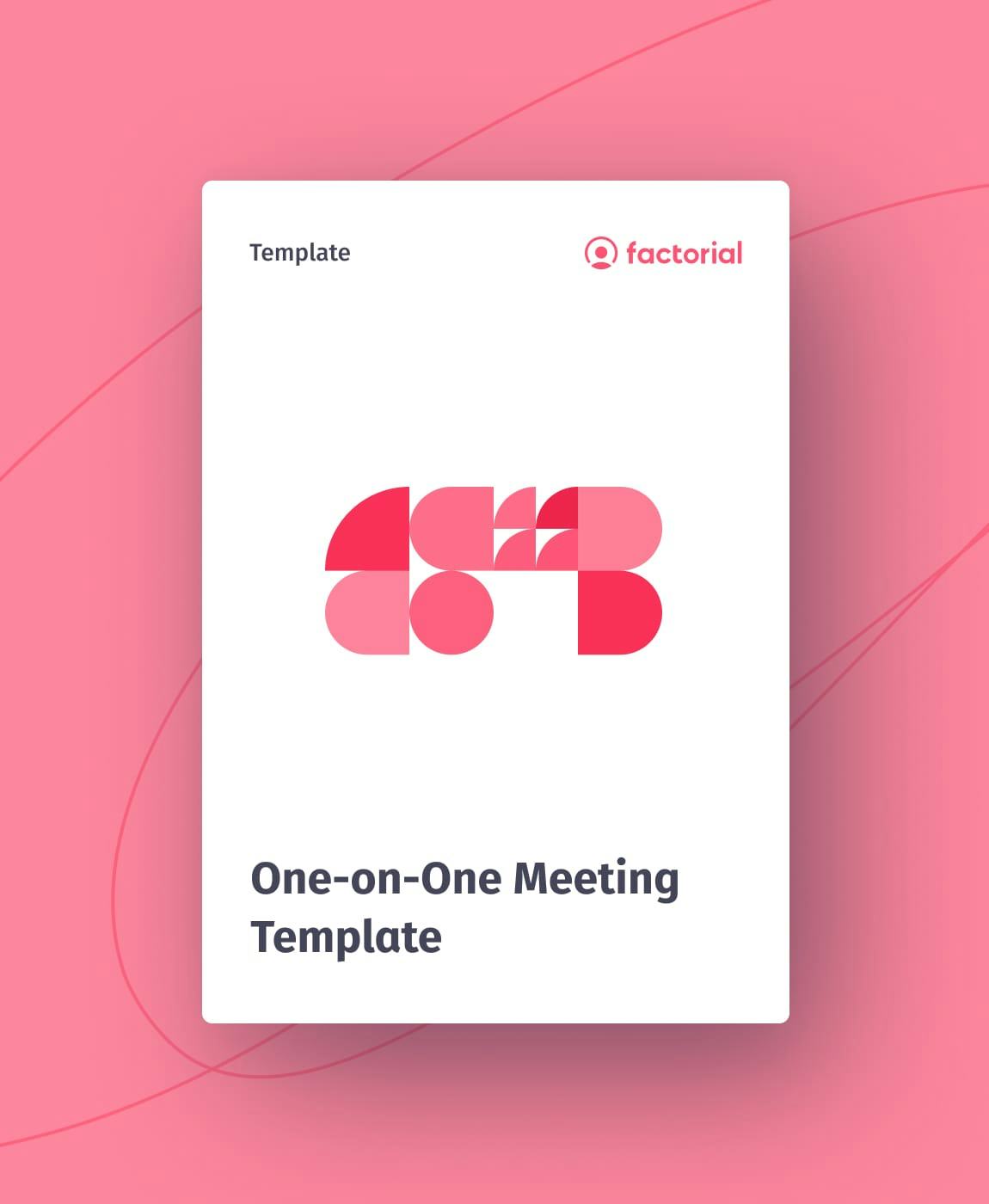One-on-One Meeting Template
One-to-one meetings, or '1:1s', are usually regular weekly or bi-weekly meetings between manager and their direct reports. They can be one of your most powerful tools as a manager and are hugely impactful to employees too.
The problem is they can be a challenge to get right. One of the most common struggles is finding the time to fit them in, and when you do, unstructured meetings can turn into status updates or complaining sessions or become repetitive from week to week. All these reasons can contribute to them falling down the list of priorities or being skipped altogether. The key is structure. And this is where 1:1 templates come in.
Our free one-on-one meeting agenda template can help managers and their direct reports get the most out of the 1:1 format, providing the structure and intent to give each team member the time and attention they need to be successful in their roles. They also ensure regular feedback and guidance, helping employees to feel valued and supported.
Using a template can also help managers be more efficient, resolve performance issues before they become problematic, and contribute to their team performance reviews.

What does this 1:1 meeting template include?
1:1 Cheat Sheet for Managers - We've included a few tips on the do's and don'ts of one-on-one meetings. Reviewing these quickly before every meeting with your team helps make your 1:1s more effective and contributes to morale, motivation, and performance.
Agenda Template - Unlike most other workplace meetings, a one-on-one meeting covers various topics, from personal development and career progression to challenges, ideas, and goals. Having an agenda ensures you and your direct report stay on track and cover everything you need in the meeting. It can also help to maintain a structure and flow to your conversation.
Questions - We've also provided a framework of questions for your 1:1 meetings. These will help guide you through the critical topics and set you up in the right style for formulating your own questions. Remember, starting with the general questions is essential for providing context for the rest of the meeting. Whether your team member has had a good or bad week will impact how you move forward, and it will also help you understand their work-life balance, well-being, and any personal situations you need to be aware of.
What's the purpose of a one-on-one meeting?
A 1:1 meeting aims to provide an informal opportunity for two people in an organisation to connect and support the direct report in their role and help them to progress. Here are some of the ways 1:1 meetings contribute to their overall purpose:

What topics should you cover in a one-on-one meeting?
Meeting agenda templates can help to build a meeting structure and offer discussion points so that both you and your direct report get the most out of these recurring meetings. Topics that should be covered include:
General Discussion: Kicking off the meeting agenda with a general discussion sets the tone for the whole meeting. Not only does it help build rapport when you ask genuine questions about how your team members are, but it can also help you gauge if anything significant is going on in their lives that might impact the meeting and their day-to-day work. This is also an excellent time to lay out the talking points for the rest of the meeting.
Professional Growth: This is the opportunity to learn more about your direct report's career goals about what they want from their role. You can discuss their short-term and long-term goals and start thinking about ways to help them achieve them. This is also a time for goal setting, planning their professional development and training, and setting expectations.
Engagement: Deep diving into your employee's engagement isn't just talking about the last week, their top priorities and any upcoming projects they're excited about; it's also about gaining a deeper understanding of how they perceive their life at work. Talk about challenges and stressors, how they are managing their work-life balance, and how you can make any changes to improve their work environment.
Productivity: This topic is multifaceted. You need to gauge your own interpretation of your direct report's productivity and also their own - and, most importantly, whether the two are aligned. Discuss their achievements and how they feel about them, their top priorities, and what they're planning to achieve in the week ahead before the next meeting. This can then be reviewed each week to start painting a picture of your team member's productivity.
Internal communication: One-on-one meetings are also a significant opportunity to garner how an individual functions within their team. Talk about productive or unproductive meetings, how they engage with their team members, and opportunities to collaborate on other projects. It's also an excellent time to discuss team housekeeping, like topics that have arisen in team meetings, team dynamics, and shared goals.
What are the benefits of using 1:1 templates?
There are a great many benefits to using a 1:1 template. Primarily, they ensure you and your team members continue to get ongoing value from the meetings, driving their progress in a structured way. At the same time, they'll also make sure they don't just turn them into status updates! But the benefits one meeting templates go a lot deeper than that; here are some you can expect to see from using a template:
- Improves Performance - A meeting template connects people to their goals and progress. A tangible record of their achievements will help them feel more empowered in their role, boosting employee engagement, motivation and accountability.
- Drives Development - Similarly, having a one-on-one meeting template can help bring your employee's career path to life. It allows them to connect what their doing now with where they're going in the future, and having a structure that involves you both working together to make that happen, ensures they feel like they have ownership and control over their choices and professional goals.
- Builds Trust - When your direct report knows precisely what to expect from their one-to-ones, even before their first meeting, it can reduce any anxiety they might feel about the process. A structured approach also gives them time to prepare and helps them to prioritise their workload, allowing them to feel supported at work.
- Improve Team Culture - A template helps you to treat individuals equally. Everyone in your team will be different, and some will find it easier to communicate their needs than others, but by using a template, you ensure that everyone is getting the same input into the process. You will also find it much easier to spot any challenges within your team, allowing you to address them before they become issues.
How to conduct one-on-one meetings with your direct reports
Set a regular time
Send a calendar invite to ensure a consistent time in the diary when it suits you as the manager and your direct report. Try not to have it directly after another meeting and make sure you've considered each other circumstances - for example, if one of you has childcare commitments straight after work, it probably wouldn't suit to have it last thing in the day. Remember - always share the meeting agendas in advance.
Prepare effective questions
The questions you prepare should open up an authentic dialogue that makes direct reports feel empowered to share their views and supported in their answers. Although it is the manager's role to guide the conversation through the talking points, it doesn't have to be a one-way street - ask them to prepare questions and topics for discussion too. Remember - think about asking open-ended questions rather than ones that require one-word answers. You can find example questions on our meeting template.
Listen actively
As a rule of thumb, in a one-to-one meeting, the employee should speak more than half the time. Active listening means listening attentively, trying to understand what they're saying before responding to and reflecting on what they've said. It also means retaining the information for later, making notetaking during a one-to-one meeting an essential component.
Share feedback
Regular one-on-ones are an excellent opportunity to discuss performance feedback in almost real time. At the same time, you also have the chance to talk about it in more detail if necessary. Your direct reports should know what great looks like and how to achieve it.
On top of that, this is an essential time for you to receive feedback - make sure you are open to it and help your team members feel comfortable doing so.
Stick to time
Sticking to the allocated time demonstrates respect for the meeting's purpose and your employee. As the facilitator of the meeting, it's your responsibility to stay with the meeting agenda and keep to time.
Build a real connection
These meetings don't just have to be your employee's goals and objectives; make sure it's as much about building rapport as it is about work.
Be positive
Even if you must discuss something difficult, start positively and finish positively. It will help your employee feel good about the meetings and the benefits they have on their career and their role at work.